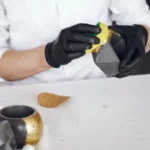1. Introduction to Testing Gold at Home
Gold, a timeless symbol of wealth, demands thorough testing for authenticity. Understanding the significance of this process, especially in today’s market filled with counterfeit items, is crucial. In this comprehensive guide, we will explore various methods for testing gold at home, placing a special emphasis on the water test method.
2. Using Water to Test Gold
Explanation of the Water Test Method
The water test is a simple yet effective way to assess the authenticity of gold. Real gold possesses a higher density than most other materials used to create counterfeit items. By comprehending how gold interacts with water, users gain a valuable tool for preliminary testing.
Step-by-Step Instructions for Conducting the Water Test
Detailed step-by-step instructions are provided for conducting the water test at home. By filling a container with water and carefully placing the gold item into it, individuals can observe specific behaviors that indicate the gold’s authenticity. This easy-to-follow process empowers users to make initial assessments confidently.

3. Understanding the Results
Interpreting the Results of the Water Test
Correct interpretation of the water test results is crucial. Genuine gold, being denser, will sink, while fake gold may exhibit different behaviors. This section offers insights into the subtle characteristics observed during the test, enabling users to make informed decisions about the authenticity of their gold items.
Differentiating Between Real Gold and Fake Gold Based on the Results
Delve into the specific behaviors exhibited during the water test to further refine the identification process. Understanding the nuances helps users differentiate between real and fake gold confidently, adding an extra layer of assurance to the testing process.
4. Limitations and Potential Inaccuracies of the Water Test
Discussing Potential Drawbacks of Using Water as a Testing Method
While the water test is accessible, it’s essential to be aware of its limitations. This section discusses potential drawbacks and situations where the water test may yield inaccurate results. Emphasis is placed on the need for additional testing methods for more valuable or intricate gold items.
Highlighting Other More Accurate Testing Methods
To provide a comprehensive understanding, alternative testing methods are highlighted. This ensures that users are aware of options that may offer greater accuracy in specific situations, guiding them toward more reliable assessments.
5. Safety Precautions When Testing Gold at Home
Importance of Handling Gold and Water Safely
Safety is paramount when testing gold at home. This section underscores the importance of handling both gold and water with care, minimizing the risk of accidents or damage to valuable items.
Tips for Ensuring a Safe Testing Environment
Practical tips are provided to establish a safe testing environment. From choosing an appropriate workspace to using the right tools, these tips help users safeguard themselves and their valuable gold items throughout the testing process.

6. Conclusion and Final Thoughts
Recap of the Water Test Method for Testing Gold at Home
Concluding the guide, a recap of the water test method reinforces the key steps and considerations for users testing gold at home. This serves as a quick reference for readers, summarizing the essential aspects of the testing process.
Encouragement to Seek Professional Testing for Valuable Gold Items
While the water test is a valuable tool for preliminary assessments, the guide encourages readers to seek professional testing for high-value or sentimental gold items. Professional testing ensures a more comprehensive analysis, offering heightened accuracy in determining the authenticity of precious gold possessions. By combining home testing methods with professional assessments, individuals can confidently navigate the landscape of testing gold, contributing to a secure and trustworthy marketplace for this timeless and precious metal.
FAQs on Testing Gold at Home with Water
The water test is a basic method and may provide initial insights, but it’s not highly reliable for determining gold purity. For accurate results, consider professional testing methods.
The water test can be applied to various gold items like coins, jewelry, and bullion. However, its accuracy may vary based on the size and density of the item.
Small or lightweight gold items may not sink clearly in water due to factors like shape and surface tension. In such cases, alternative testing methods are recommended.
No, the water test is non-destructive and won’t harm your gold items. It’s a safe and quick method for a preliminary assessment.
The water test primarily assesses density, making it challenging to differentiate between various gold alloys. For detailed information, chemical or professional testing is more suitable.
Acid testing is a more accurate method for determining gold purity as it involves chemical reactions. The water test is simpler but less precise, providing a quick, non-destructive alternative.
Besides the water test, you can use a magnet to check for magnetism (gold is not magnetic), or invest in an acid testing kit for a more detailed analysis of gold purity.
Tap water is suitable for the water test. The goal is to observe the sinking behavior of the gold item, and using regular tap water is sufficient.
Genuine gold, being dense, should sink rapidly and stay at the bottom. However, this doesn’t guarantee purity, and for precise information, consult professional appraisers or jewelers.
Yes, professional testing is advisable, especially for valuable or sentimental gold items. Experts can provide accurate information about purity and value through advanced testing methods.



GIPHY App Key not set. Please check settings
One Comment